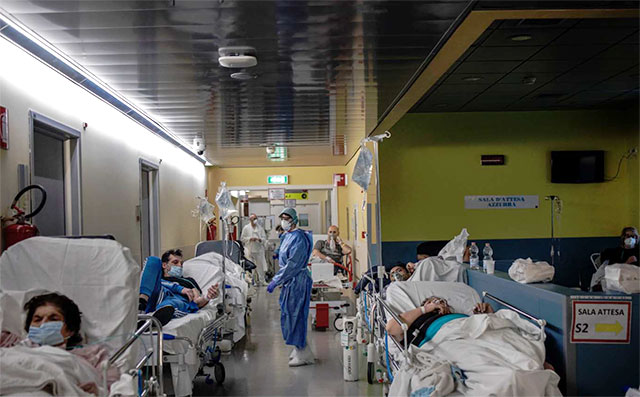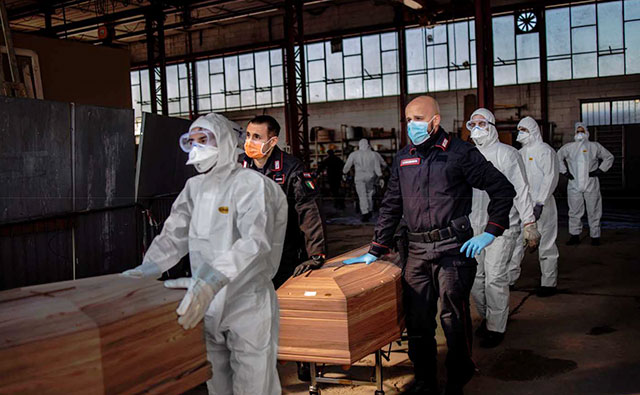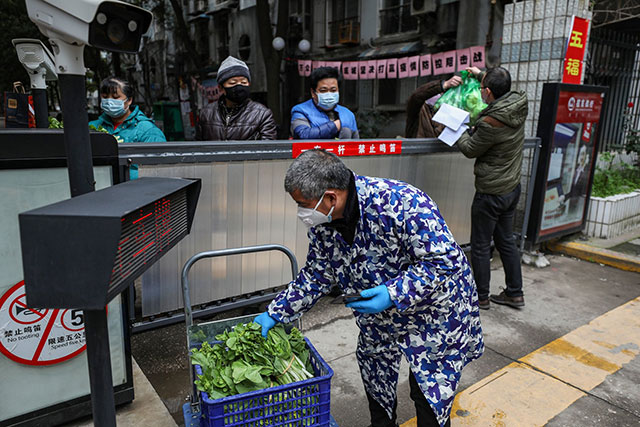
April 2020
While Chinese Workers State Contained Outbreak
Coronavirus Pandemic Ravages
Italy,
Overwhelms Capitalist Medical System

Intensive care patients lined up in hospital corridors in Bergamo province, March 2020. (Photo: Fabio Bucciarelli)
APRIL 4 – Italy is where the novel coronavirus COVID-19 hit Western Europe first and hardest. The result has been devastating, dramatically exposing the inability of the capitalist system to protect the lives of the population, much less provide adequate medical care. The extremely high mortality (as of April 4, over 15,362 dead out of some 125,000 confirmed cases),1 overwhelmingly among the elderly, has shaken the country, which has a much higher number of very old people than elsewhere in Europe. The lack of medical equipment has led to doctors triaging infected patients, in effect deciding whom they would let die. Meanwhile, the seriously belated quarantine measures are simultaneously leaky in major cities like Milan and enforced with a heavy hand by police, Carabinieri (paramilitary national police force) and the military elsewhere.
The criminally passive response by the authorities in the early stages, when it would have been possible to more effectively contain the spread of the virus, has become notorious, with the head of the ruling bourgeois Democratic Party posting a video at the end of February urging Italians “not to change our habits,” only to post a second video ten days later of himself having fallen ill from the coronavirus. But the exploding public health disaster in Italy reflects the massive cuts in health care that have been carried out particularly since the onset of the world capitalist economic crisis in 2007-08. Over the past decade, €37 billion (US$40 billion) has been slashed from public health, 70,000 hospital beds have disappeared and 359 hospital departments have been closed. In Italy the number of hospital beds per 1,000 people is 3.2, compared to 6 in France and 8 in Germany.

Italian army has been called in to move the dead from warehouses to crematoria. (Photo: Fabio Bucciarelli)
Already two years ago, the Nurse Times (11 June 2018) quoted the condemnation made by the SMI (an Italian doctors trade union) at its national congress in Naples:
“The hiring freeze has been in place for ten years, resulting in a bizarre mix of contracts, some freelance, some by the day and some by the hour, thereby burning out an entire generation of professionals: public employees overall have lost something like €10 billion a year.
“During the congress we were also reminded that in the near future, the retirement of health workers and their not being replaced (19,000 general doctors and 55,000 specialists) will lead to the disappearance of health care for citizens.”
By mid-March, in Lombardy in northern Italy, the center of the crisis, temporary intensive care units were set up in corridors, operating rooms, recovery rooms. Other hospital departments were cleared out and regular medical visits cancelled. The provinces of Bergamo and Brescia have been so overloaded that facilities there could not accept new patients, while in much of Lombardy they have been close to collapse. Patients, both with coronavirus and without, are being transferred to other parts of Italy, a fraught task. Doctors, nurses and other health-care workers have for weeks been working 12-hour shifts, or more, and have already been pushed beyond the limit.
The mayor of Bergamo, Giorgio Goro, has said that the gap between resources and the enormous flux of patients “forced the doctors to decide not to intubate some very old patients,” essentially leaving them to die. Other health workers declare “we are forced to choose between people in their ’40’s and people in their ’60s.” The doctors cry out, “It is a catastrophe.” With an acute shortage of ambulances, it can reportedly take up to an hour for one to respond to emergency calls. This delay can be fatal for those with heart attacks and serious respiratory crises. The shortage of medical personnel is so acute that even the xenophobic ultra-rightist government of the fascistic Lega in Lombardy has appealed for Chinese, Cuban and Venezuelan health workers to go to their to help. All three of these countries are now sending aid.

Police at checkpoint in Viale Porpora in Milan stop drivers during the lockdown, March 2020.
(Photo: Alessandro Grassani for The New York Times)
At last count, more than 10,600 nurses and health-care workers have been infected by the coronavirus and 77 doctors have died from it. The doctors trade union Anaao-Assomed says the number of fatalities among medical personnel continues to grow and condemns the “persistent insufficiency” of personal protective equipment, starting with surgical masks. Doctors are “left naked before the virus,” it declared. The regional health director of Lombardy, Giulio Gallera, complained that surgical masks that arrived from the national Civil Protection authorities were little better than “toilet paper.”
Lombardy saw early outbreaks, due to intense commercial and travel contact with China, where the coronavirus was first detected. But reports also show that the failure to stop much of the ordinary daily commute of over 700,000 people on the Milan metro (subway) and buses has meant that the infection continues to be spread every day. The left press and even some bourgeois media have shown pictures of jampacked metro cars with people literally squeezed together. So what has been advertised outside of Italy as something close to a “total lockdown” in reality hasn’t been that. Also, there has been far from enough testing.
There are a number of additional reasons why COVID-19 spread much more extensively in Lombardy than in other parts of Italy. One is football (soccer) tourism, with tens of thousands of fans traveling from city to city. But particularly important is the fact that in Lombardy, the richest part of Italy, health care has been largely privatized as more people can afford to bypass long waiting lists in public hospitals. These private clinics covered up the existence of coronavirus in their facilities in order to avoid being closed down.2 Instead, they listed the illness as asthma, or old age, or respiratory problems. People suspected of having COVID-19 were sent home to self-isolate, where unknowingly, they infected family members, who in turn infected many others. They were not placed in isolation centers attended by medical personnel, as happened in China. This made a huge difference.
China: The Superiority of a Planned Economy

Huoshenshan Hospital in Wuhan, China. China built two 1,000-bed hospitals in ten days from start to finish, to treat coronavirus patients in the epicenter of the outbreak. (Photo: CNN)
In contrast to this bleak and terrifying picture of the situation in capitalist Italy, where the coronavirus pandemic continues to rage out of control and where some scenes recall paintings of medieval plagues, by mid-March, China had largely (but not completely) beaten back the pandemic. New infections in China, once about 2,500 a day, fell to 5-20 a day, most of these being of foreigners who have brought it into China from where they live abroad. So China is now quarantining those entering the country. Highlighting this, Apple announced that it is closing all of its stores in the world, except for those in China, which it is reopening.
China’s all-out mobilization against the coronavirus was not perfect, with some initial delay in recognizing the gravity of an outbreak of an initially undetermined pathogen, as well as some bureaucratic missteps. But once it became a national priority, the vast superiority of a planned economy in a workers state, albeit bureaucratically deformed, kicked in. China rapidly reassigned not only tens of thousands of medical personnel, but people from all sections of society. It reorganized hospitals to provide specialized care for the acutely sick, built two hospitals in record time (ten days, from start to finish), turned sports arenas and gymnasiums into isolation centers, speeded up the massive use of CT (computerized tomography) scans, and ensured that the population was supplied with food.
All of this and more was documented in an interview with Canadian doctor Bruce Aylword, who led the World Health Organization (WHO) mission of 25 experts that visited China for two weeks in early February to assess the country’s response to the coronavirus outbreak (New York Times, 4 March) and in the Report of the WHO-China Joint Mission on Coronavirus Disease 2019 (Covid-19). As the WHO report detailed, there was a total lockdown in the epicenter of the pandemic, Wuhan, and in nearby cities. Half of all medical care was moved online so people did not need to go to the doctor or to hospitals. Prescriptions for items like insulin or heart medications were delivered to homes. China produced 1.6 million kits for testing per day and the test results were given out within four hours.
Other provinces sent 40,000 medical workers to Wuhan, many of whom were volunteers. Government employees were reassigned. They delivered food, took temperatures or became contact tracers. Fifteen million people had to order food online. It was delivered. Testing was free and the government made it clear that if your insurance ended, the state paid everything if it was Covid-19. On the other hand, the fact that residents of urban areas are covered – or not – by health insurance shows that they do not have free health care and medicine in China, as used to be the case before the Stalinist bureaucracy introduced privatizing “reforms” begun under Deng Xiaoping in the late 1970s. Today, there are private clinics, joint-venture medical facilities as in the West as well as V.I.P. wards in public hospitals.

Delivering fresh vegetables to residents of quarantine zone, Wuhan, March 2020.
(Photo: Agence France-Presse)
Coming off of the successful fight against the coronavirus, which dramatically showed what a planned, centrally directed economy can accomplish, revolutionary communists in China would fight for a fully socialized medical system and free, high-quality health care for all, as part of the Trotskyist program for proletarian political revolution.
The WHO reported: “In the face of a previously unknown virus, China has rolled out perhaps the most ambitious, agile and aggressive disease containment effort in history.” In response to a New York Times journalist who “asked” tendentiously, “Isn’t all of this [the anti-coronavirus mobilization in China] possible only because China is an autocracy?” Aylward responded: “Journalists also say, ‘Well, they’re only acting out of fear of the government,’ as if it’s some evil fire-breathing regime that eats babies. I talked to lots of people outside the system – in hotels, on trains, in the streets at night. They’re mobilized, like in a war, and it’s fear of the virus that was driving them. They really saw themselves as on the front lines of protecting the rest of China. And the world.”
The scope of the successful actions and coordination in China against the coronavirus could only be done in a workers state with a planned economy. The structural chaos and anarchy of the capitalist economy is determined by production for profit, which renders it incapable of effective coordinated intervention. The current crisis also shows the complete inability of the various capitalist countries to wage any type of joint effort and coordination to fight against the worldwide pandemic, as every country – and often different regions or states within a single country – pursues its own individual policies of action or inaction. The coronavirus crisis makes crystal clear the urgent need for international socialist planning.
Workers Fight for Their Lives

Workers at TNT in Piacenza shut down the plant, March 24. (Photo: SI Cobas)
Meanwhile, working people in Italy have been exposed to the coronavirus threat by bosses who care nothing for their health and safety. There has been a wave of spontaneous strikes and walkouts across Italy as workers refuse to labor without protective clothing and equipment and safe conditions. The chant, “We are not lambs to be led to the slaughter” has caught on among strikers. The pressure from the ranks in factories and workplaces has been such that the CGIL-CISL-UIL trade-union bureaucrats rushed to try to calm the situation by signing an agreement on March 14 with the bosses and government “for the good of the country,” to ensure that “Italy will not shut down.” This accord resolved very little, leaving safety to the discretion of management. Several FCA (Fiat Chrysler) auto factories and other plants have been closed down for a time, supposedly to implement safe working conditions, as tensions remain high.
Then came further strikes, including widespread coordinated ones on March 18 and 25, notably at the courier services of TNT, SDA, DHL and other logistics worksites. The threat of an unlimited general strike coming from sections of the labor movement forced the government and companies to close down more production. There have also been walkouts at Amazon for safe working conditions, which have put deliveries in crisis. Trade-union and worker safety committees must shut down production in the case of unsafe working conditions. We demand full pay for all those who are out of work because of this crisis.
The Nucleo Internazionalista d’Italia, section of the League for the Fourth International, translated and posted the call “For Workers Action in the Coronavirus Crisis” by Class Struggle Workers – Portland. On social media, the NId’I called as well for “Tests for all in workplaces!” “No reliance on those who care nothing for the lives of workers!” and “For trade-union/workers control with the presence of doctors!”
Meanwhile, Chinese experts and doctors arrived in Rome on March 12, along with 31 tons of material to fight against the virus. This included ventilators, anti-infection suits, anti-virus surgical masks and other protective equipment, in addition to medicine and samples of plasma to use for research. Other material will soon arrive. The Chinese government is mobilizing to reportedly send 1,000 ventilators, more than 2 million surgical masks (including 100.000 high-tech units), 20,000 protective suits and 50,000 swabs for coronavirus tests. This material will save many lives. Luigi Di Maio, the Italian foreign minister greeted the arrival of the Chinese doctors, experts, equipment and aid, saying: “This is what we define as solidarity” (la Repubblica, 13 March). While a bitter irony that this comes from a minister in this vile bourgeois government, his comment and favorable media coverage contrasts with the virulent anti-communist China-bashing in the U.S.
There have, however, been some physical and verbal attacks against Chinese and others of Asian origin around the country amidst the coronavirus crisis. Almost 300,000 Chinese are living in Italy, 23,000 of them in Prato, a small city outside Florence. They mostly toil in sweatshops and live in the shadows, with little integration. The SI Cobas (rank-and-file unions) have sought to organize there and worker demonstrations have been held, but at the same time there have been some beatings of the first union members. The Chinese community in Prato closed down all activity before the nationwide lockdown. As a result, there has not been a single known case of COVID-19 in that community, even after 2,500 returned from China following the lunar New Year holiday (La Nazione, 21 March).
The unprecedented successful mobilization in China against the coronavirus, and now China’s aid to Italy and the sharing of its valuable scientific research internationally, shows the enormous advantage of a planned economy over capitalist profit-driven anarchy and chaos. While various pseudo-Trotskyist groups, social democrats, anarchists, Bordigists, feminists and various others echo the anti-communist attacks on China by the imperialist powers, we of the Nucleo Internazionalista d’Italia/LFI stand for the unconditional military defense of the Chinese deformed workers state against imperialism and for proletarian revolutionary mobilization against internal forces of counterrevolution that threaten the gains of the 1949 Chinese Revolution, while fighting for socialist revolution in Italy and internationally. ■
- 1. According to the Johns Hopkins COVID-19 tracker (https://www.arcgis.com/apps/opsdashboard/index.html).
- 2. “Perché in Lombardia si muore?” (Why Are People Dying in Lombardy), 22 March, at: https://www.tpi.it/opinioni/coronavirus-perche-lombardia-si-muore-errori-fontana-commento-selvaggia-lucarelli-20200322570859/
